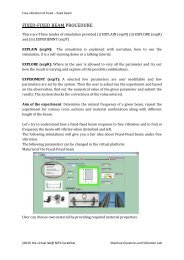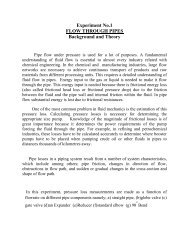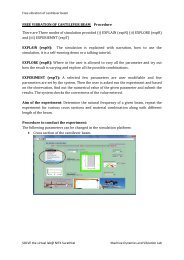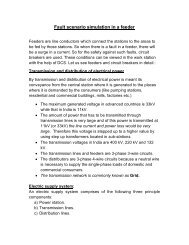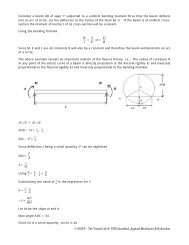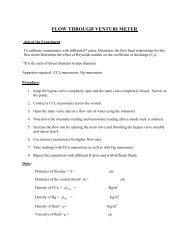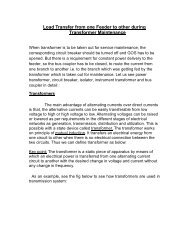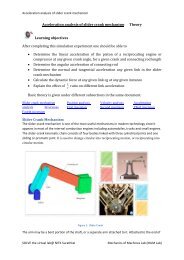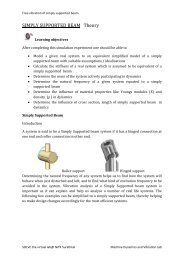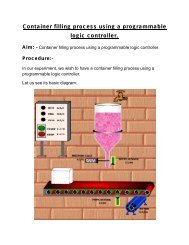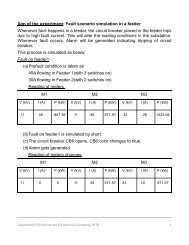Experiment No.5 Flow through Packed Bed Background and Theory
Experiment No.5 Flow through Packed Bed Background and Theory
Experiment No.5 Flow through Packed Bed Background and Theory
- No tags were found...
Create successful ePaper yourself
Turn your PDF publications into a flip-book with our unique Google optimized e-Paper software.
<strong>Experiment</strong> <strong>No.5</strong><strong>Flow</strong> <strong>through</strong> <strong>Packed</strong> <strong>Bed</strong><strong>Background</strong> <strong>and</strong> <strong>Theory</strong>Chemical Engineering operations commonly involve the use of packed beds.These are devices in which a large surface area of contact between a liquid <strong>and</strong> agas ,or a solid <strong>and</strong> a gas or liquid is obtained for achieving rapid mass <strong>and</strong> heattransfer <strong>and</strong> for chemical reactions.<strong>Packed</strong> bed column is a cylindrical column packed with certain packingmaterial. The packing can be r<strong>and</strong>omly filled with small objects like Raschig ringsor else it can be a specifically designed structured packing . Several chemicalengineering unit operations such as absorption, adsorption, distillation <strong>and</strong>extraction are carried out in packed columns. These packings enhance the surfacearea available for transfer operations. <strong>Packed</strong> columns are also used forheterogeneous catalytic reactions. The packed bed configuration also facilitates theintimate mixing of fluids with mismatched densities, largely due to increasedsurface area for contact.<strong>Flow</strong> <strong>through</strong> a packed bed can be regarded as fluid flow past some number ofsubmerged objects. When there is no flow <strong>through</strong> the packed bed, the netgravitational force (including buoyancy) acts downward. When flow beginsupward, friction forces act upward <strong>and</strong> counterbalance the net gravitational force.The frictional force can be expressed in terms of a friction factor. This leads toequations describing the flow of a fluid past a collection of particles. From a fluidmechanical perspective, the most important issue is that of the pressure droprequired for the liquid or the gas to flow <strong>through</strong> the column at a specified flow
ate. The pressure losses accompanying the flow of fluids <strong>through</strong> packed columnsare caused by simultaneous kinetic <strong>and</strong> viscous energy losses. The essential factorsdetermining the energy loss, i.e. pressure drop, in packed beds are:1. Rate of fluid flow2. Viscosity <strong>and</strong> density of the fluid3. Closeness <strong>and</strong> orientation of packing4. Size shape <strong>and</strong> surface of the particlesThe first two variables concern the fluid, while the last two the solids.To calculate the pressure losses, we rely on a friction factor correlationattributed to Ergun.The frictional force can be expressed in terms of a friction factor. This leadsto equations describing the the flow of a fluid past a collection of particlesThereare several approaches to treating fluid flow <strong>through</strong> packed beds. The mostsuccessful of these is the Ergun Equation, which describes flow in both the laminar<strong>and</strong> turbulent regimes. This method treats the packed column as a compactirregular bundle of tubes.Modifying the theory for straight tubes not only takes intoaccount the irregularity of the tubes,but yields relationships similar to thosederived for straight tubes as well.This analysis assumes several conditions. First, we assume that the particles arepacked in r<strong>and</strong>om; there is no channeling inthe packed bed. Channeling occurs
when the fluid flowing <strong>through</strong> the packed bed finds a “preferred path” <strong>through</strong> thebed. We also assume that the diameter of the packing is much smaller than thediameter of the column as well. The maximum recommended particle diameter isone-fifth of the column diameter. We assume that velocity, particle diameter <strong>and</strong>void fraction behaves as a bulk behavior <strong>and</strong> hence we can use an average values.The Ergun equation is(1)is the friction factor for a packed bed called as modified friction factor.Where (2)WithL= the height of the bedµ=the fluid viscosityε=the fluid viscosityV o = the fluid superficial velocityD p =the particle diameter
ρ= the density of the fluidφ s = sphericity of the particle.Ergun equation was obtained by fitting the data for spheres,cylinders <strong>and</strong> crushedsolids such as coke <strong>and</strong> s<strong>and</strong>. For Raschig rings <strong>and</strong> Berl saddles, which haveporosities of 0.55 to 0.75, Ergun equation predicts pressure drops lower than thosefound experimentally. It also does not apply well to other tower packings of highsurface area <strong>and</strong> high porosity.It is seen from the formula that when the flow is high,the turbulent part of theformula appears; likewise, when the flow is low, the laminar part of the formulacomes out. Thus, the Ergun equation can be used for any type of flow.The Ergun equation tells us a number of things. It tells us the pressure drop alongthe length of the packed bed given some fluid velocity. It also tells us that thepressure drop depends on the packing size, length of bed, fluid viscosity <strong>and</strong> fluiddensity.At low Reynolds numbers,the quantity 1.75 of Eq.(1) is negligible in comparisonwith Reynolds number term.This implies that the viscous forces control <strong>and</strong> thatinertial forces are unimportant. Then we have=150This is called the Kozeny-Carman equation <strong>and</strong> is a laminar flow equation, to beused when N Rep is less than about 1.For a given system it indicates that the pressuredrop is directly proportional to the flow rate.
For large Reynolds numbers,above about 1000,the first term on the right h<strong>and</strong> sideof Eq.(1) fades out as viscous forces become negligible <strong>and</strong> inertial forces control ,ThenThis is called Blake Plummer equation.For large Reynolds numbers,above about1000 pressure drop is propotional to square of velocity.In addition to Ergun’s correlation, another model, the Leva’s equation iscommonly utilized in the prediction of pressure drop versus flow rate. Leva’sequation, based on the study of single incompressible fluids <strong>through</strong> anincompressible bed of granular salts, is relatively similar to the structure of theErgun equation.Commonly used Tower packingsRaschig rings
Pall ringsBerl saddlesIntalox saddles



